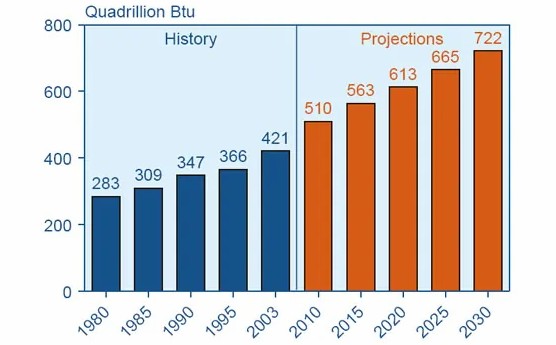Energy demand is increasing globally annually at a 2% rate. The graph appearing at the top of this article projects consumption trends to the end of this decade. Reaching out to 2040, at the current 2% annual increase in demand, it means we will have doubled the energy we were consuming back in 2007, fifteen years ago.
Consumption of energy is an unequal game. North America, Asia, and Europe are disproportionately energy hogs. They consume most of the fossil fuels burned which is the cause of anthropogenic climate change. Our North American and European homes need to be heated in the winter and chilled in the summer. And then there are the technological gadgets that fill our homes and have us consuming more energy than all of Africa, South America, and Oceania combined.
That’s why energy conservation leading to reduced consumption and lower emissions is an important weapon in our arsenal to combat climate change. This means we need to look at the contributing factors to our energy-hog lifestyle. It means changing our behaviour.
Making lifestyle changes is easier if one can see the goal ahead. The problem with climate change is we likely cannot or will not see the results of our behavioural changes during our lifetimes. As a result, we walk slowly towards the change we need to make rather than run to embrace it.
Here in Canada as well as in the United States and Europe, most of us live in cities. Canadian and American cities are relatively young. European ones are older. The buildings in the Americas are largely 20th-century constructs. The buildings in Europe are a mix of old and new. Whether dealing with structures dating back to the Middle Ages, or those more contemporary, very few of the legacy buildings that dominate our cities have been designed with energy conservation in mind.
That’s why cities need to come up with smart policies and programs backed by funding both public and private to address energy conservation. Correcting the energy inefficiency in legacy buildings needs to be a high priority. Doing it will help cities to get to net-zero emissions faster than almost any other policy or program they initiate. It is, however, easier to have aspirations to achieve this, than it is to accomplish it.
For example, my home city, Toronto, has more than 450,000 legacy buildings in its inventory with the vast majority built pre-1970. These include:
- individual standalone homes
- semi-residential and townhouses
- multi-unit residential buildings including rentals and condominiums
- commercial retail and industrial low-rise buildings
- large commercial high-rise towers dominating the city core
- arenas, sports and recreational venues
The vast majority of these buildings have not been designed to conserve energy. And so far, the city, other than looking at its own inventory of 500 buildings or so, hasn’t created policies and funded programs focused on energy conservation. The city’s website refers only to federal grants for homeowners to do energy audits and retrofits.
Why should Toronto act on energy conservation for its legacy buildings? Below is a picture of the City of Vancouver taken using an infrared thermal imaging scanner. The yellow appearing in the image indicates where heat is leaking from surface areas. The biggest contributors are windows and doors, with roofs and walls coming in second. For Vancouver as in Toronto, the vast majority of buildings predate 1970 when building codes didn’t consider specifications focused on energy conservation.
This infrared image of the City of Vancouver, British Columbia, shows where conservation of energy improvements need to be applied. (Image credit: City of Vancouver)
Today in Canada, most energy consumed by residential and commercial properties gets used to heat spaces. And based on what we can see from infrared thermal images like the one above, a significant percentage of that energy for heating goes right out the windows, doors, roofs and walls.
Cities as environmental stewards and as the place where most of us live can do far more to mitigate climate change if they would focus on energy conservation to support residential and commercial property retrofits. That means putting in place programs to replace legacy windows and doors with energy-efficient ones. It means programs that subsidize insulating walls and ceilings.
The City of Denver and its Office of Climate Action, Sustainability and Resiliency has a five-year plan featuring a Climate Protection Fund. The money is to help improve the energy efficiency of homes, offices and industrial sites. Public seed capital of $40 million established the program which has since attracted private contributions to help increase its capacity to achieve the goal of zero emissions in all legacy buildings by 2040.
The Canadian federal government’s 2030 Climate Emissions Plan has put aside $1 billion for a green buildings strategy that includes energy retrofits. This is the money that Toronto describes on its website covering energy-efficient upgrades for new windows, doors, and insulation up to $5,000 per homeowner. There is no money for multi-residential units or condominiums. And the city isn’t adding any more funds or trying to attract money from private contributions to make the program more effective.
In the face of climate change, this lack of smart urban policy needs to change. Addressing energy conservation in legacy buildings can do more for reducing energy demand which means less burning of fossil fuels, and help in mitigating climate change. This is needed now for the sake of future generations for the overall health of the planet and the people on it.

















